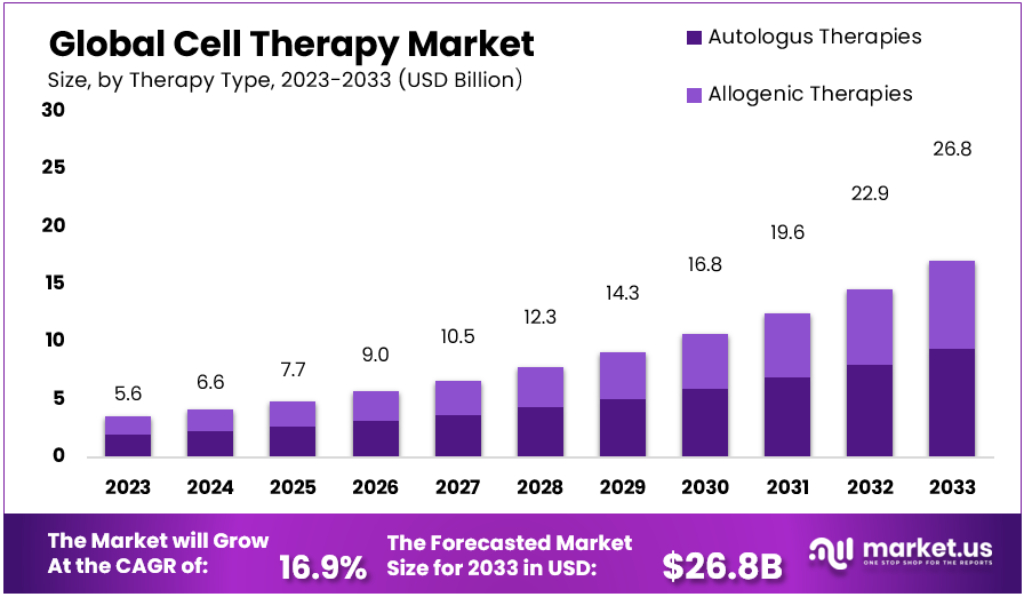Introduction
The Global Cell Therapy Market Size is projected to grow from USD 5.6 billion in 2023 to USD 26.8 billion by 2033, at a robust CAGR of 16.9%. This growth is driven by advancements in biotechnology, regulatory support, strategic acquisitions, and rising demand for personalized medicine. Key innovations, such as automated production platforms by companies like Cellares, are improving efficiency and reducing costs, significantly boosting the industry’s scalability.
Regulatory authorities, including the U.S. FDA, are offering clearer guidance on cell and gene therapy development, streamlining approval processes. These supportive measures are creating a conducive environment for investment and innovation. Additionally, major pharmaceutical firms are acquiring cell therapy companies to expand their portfolios. Roche’s acquisition of Poseida Therapeutics for $1.5 billion exemplifies this trend, reflecting growing confidence in the market’s potential.
The rising demand for personalized medicine, particularly in oncology, is another critical growth driver. CAR-T cell therapies, which use patients’ cells to combat cancer, are gaining traction. Efforts to improve manufacturing processes are making these therapies more accessible. Moreover, successful clinical outcomes, such as Sarepta Therapeutics’ Elevidys receiving expanded FDA approval for Duchenne muscular dystrophy, underscore the effectiveness and promise of these treatments.
With increasing investments, technological advancements, and regulatory support, the cell therapy market is poised for significant expansion. The focus on efficiency, accessibility, and clinical efficacy will further cement its role in shaping the future of healthcare.

Key Takeaways
- The global cell therapy market is projected to expand from USD 5.6 billion in 2023 to USD 26.8 billion by 2033, growing at a CAGR of 16.9%.
- Autologous therapies, utilizing patients’ own cells, dominate the market in 2023 with over a 91% share, highlighting their widespread adoption.
- Oncology cell therapies hold a 37% market share in 2023, showcasing their significant role in cancer treatment advancements.
- Cell therapies targeting cardiovascular diseases address critical heart-related issues, underscoring their importance in treating cardiovascular health challenges.
- North America leads the cell therapy market in 2023, accounting for 53.4% of the global share due to strong healthcare infrastructure.
- The U.S. is home to five of the world’s top eight universities specializing in stem cell research, reinforcing its global leadership.
- The Asia Pacific cell therapy market is forecasted to grow at a 14.6% annual rate, driven by expanding healthcare investments and technological advancements.
Regional Analysis
North America is expected to hold 53.4% of the global cell therapy market share in 2023. This dominance is attributed to the presence of numerous centers and institutes engaged in stem cell therapy research and development. Five of the eight leading universities in the field are based in the U.S., including the Institute for Stem Cell Biology and Regenerative Medicine, Yale Stem Cell Center, and Harvard Stem Cell Institute. These institutions contribute significantly to advancing cell therapy research and innovations.
The Asia-Pacific cell therapy market is projected to grow at a compound annual growth rate (CAGR) of 14.6% during the forecast period. The region’s emerging economies are anticipated to generate substantial revenue, driven by growing investments from developers and consumers in advanced medical treatments. This trend reflects increasing demand for innovative healthcare solutions and technologies in countries like China, India, and South Korea. Collaborative efforts within the region also foster the development of stem cell therapies.
Many Asian countries are forming stem cell alliances to streamline and enhance research and development efforts. These collaborations aim to accelerate innovation in cell therapy technologies and clinical applications. The region’s favorable legal framework plays a critical role in attracting global attention. Patients from Western countries often travel to Asia for treatment, taking advantage of advanced procedures and cost-effective options. This trend underscores the region’s growing influence in the global cell therapy market.
The robust growth of cell therapy in Asia-Pacific is complemented by increasing support from governments and private investors. Flexible regulations encourage the establishment of R&D centers, facilitating progress in cutting-edge treatments. These developments position Asia-Pacific as a hub for medical advancements in regenerative medicine. The rising adoption of stem cell therapies in the region reflects a broader global shift toward personalized and precision medicine, further enhancing its market potential.
Emerging Trends
- Enhanced Treatments for Blood Cancers: Cell therapies, especially CAR-T (Chimeric Antigen Receptor T-cell) treatments, are transforming the fight against blood cancers. These therapies have shown remission rates exceeding 80% in some leukemia and lymphoma patients, representing a significant breakthrough. Researchers continue to refine these treatments, aiming to improve their effectiveness and durability. The high success rates highlight CAR-T’s potential as a life-saving option for blood cancer patients. With ongoing research, the outcomes are expected to improve further, making these therapies a cornerstone of cancer treatment.
- Progress in Treating Solid Tumors: Solid tumors, like those found in pancreatic cancer and glioblastoma, have traditionally been challenging for cell therapies. However, recent innovations are beginning to change this narrative. Advanced techniques, such as engineered immune cells, are showing promise in targeting these tumors. While progress is still in its early stages, clinical trials have demonstrated encouraging results. These advancements could significantly broaden the scope of cell therapy, making it a viable treatment for a wider range of cancers. This expansion could offer hope to patients with previously untreatable conditions.
- Breakthroughs in Autoimmune Disease Treatment: Cell therapy is also making strides in treating autoimmune diseases, such as lupus, multiple sclerosis, and type 1 diabetes. For example, CAR-T therapy has successfully induced remission in lupus by resetting the immune system. These results suggest that similar approaches could be used for other autoimmune conditions. The ability to modulate the immune system through cell therapy offers a revolutionary way to manage diseases previously thought incurable. As research continues, these therapies are likely to become more widely applicable in autoimmune treatment.
- Advances in Manufacturing and Delivery: Efforts to streamline cell therapy production are reducing costs and improving accessibility. Innovations like automated production systems and in vivo manufacturing strategies are leading the way. These advances can shorten manufacturing times and lower the price of treatment, making therapies available to more patients. Simplified production processes could also enhance scalability, helping to meet the growing demand for these treatments. By addressing logistical challenges, these innovations are poised to revolutionize the availability of cell therapies worldwide.
- Personalized Medicine in Cell Therapy: Personalized medicine is gaining prominence in cell therapy, with treatments increasingly tailored to individual patients. By aligning therapies with genetic profiles, researchers are improving effectiveness while minimizing side effects. This approach ensures that treatments are both precise and patient-centered, enhancing overall outcomes. Personalized therapies represent a shift towards more effective and efficient care. As technology advances, the ability to customize treatments will likely become a standard practice in the field of cell therapy, offering new hope for patients with diverse medical needs.
Use Cases
- Hematopoietic Stem Cell Transplantation: Hematopoietic stem cell transplantation is a life-saving therapy for blood disorders like leukemia and lymphoma. This treatment involves replacing damaged or diseased bone marrow with healthy stem cells, enabling the production of normal blood cells. For certain cancers, it has become a standard option, significantly increasing survival rates. Patients who undergo this therapy often regain their health and quality of life. Over the years, advancements have made the procedure safer and more accessible, making it a cornerstone treatment for many blood-related conditions.
- CAR-T Cell Therapy for Cancer: Chimeric Antigen Receptor T-cell (CAR-T) therapy is revolutionizing cancer treatment, especially for blood cancers like leukemia. A well-known success story is Emily Whitehead, who went into remission after receiving CAR-T therapy for acute lymphoblastic leukemia, a condition that did not respond to conventional treatments. This therapy uses genetically modified T-cells to target and destroy cancer cells. Its ability to provide long-lasting remission has brought new hope to patients with limited options, making it a breakthrough in modern oncology.
- Stem Cell Therapy for Type 1 Diabetes: Stem cell therapy has shown promise in treating type 1 diabetes, as seen in a remarkable case in China. A 25-year-old woman, who underwent stem cell transplantation, began producing insulin naturally, eliminating her need for external insulin supplementation. Her glucose levels stabilized for over a year following the treatment. This innovative approach offers a potential cure for type 1 diabetes, a condition previously managed only through lifelong insulin therapy. It represents a significant step forward in regenerative medicine and diabetes care.
- Treatment of Autoimmune Diseases: Autoimmune diseases like lupus have seen groundbreaking treatment advancements with CAR-T cell therapy. By reprogramming the immune system, this therapy has induced remission in patients with severe lupus, a condition resistant to traditional treatments. The therapy works by eliminating defective immune cells and allowing the body to regenerate a healthier immune system. Its success has sparked optimism for its potential use in treating other autoimmune conditions, paving the way for a new era in immune system management and therapy.
- Cardiac Repair in Children: Researchers in Melbourne are exploring stem cell therapy to address heart failure in children. Their innovative approach involves converting stem cells into functional heart cells and injecting them into damaged areas of the heart. This treatment aims to improve cardiac function and potentially reverse heart damage. Clinical trials are expected to begin soon, offering hope for young patients suffering from congenital or acquired heart conditions. If successful, this therapy could transform pediatric cardiac care and reduce the need for heart transplants in children.
Conclusion
The cell therapy market is poised for remarkable growth, driven by advancements in biotechnology, supportive regulations, and rising demand for personalized medicine. Innovations like CAR-T therapies and automated manufacturing processes are enhancing accessibility and efficiency, making treatments more effective and scalable. The increasing focus on conditions such as cancer, autoimmune diseases, and heart ailments highlights the broad applicability of cell therapies. With North America leading in research and Asia-Pacific emerging as a key growth hub, global investments and collaborations are fueling progress. As cell therapy continues to evolve, its potential to transform healthcare is undeniable, offering hope for better treatments and outcomes for patients worldwide.
Discuss your needs with our analyst
Please share your requirements with more details so our analyst can check if they can solve your problem(s)



